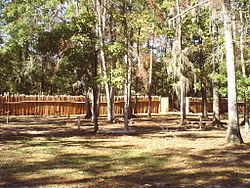Fort Mims
| Fort Mims | |||||||
|---|---|---|---|---|---|---|---|
| Part of Creek War | |||||||
 The Battle |
|||||||
|
|||||||
| Belligerents | |||||||
| Red Stick Creek |
|
||||||
| Commanders and leaders | |||||||
|
Head warriors (Tastanagi): William Weatherford Peter McQueen |
Major Daniel Beasley Dixon Bailey |
||||||
| Strength | |||||||
| 750-1,000warriors |
265 militia, including:
|
||||||
| Casualties and losses | |||||||
| 50 to 100 killed unknown wounded |
265 militia killed or captured 252 civilians killed or captured unknown wounded Fort Mims severely damaged |
||||||
|
Fort Mims Site
|
|

Inside the reconstructed fort, looking at the west wall and gate.
|
|
| Nearest city | Tensaw, Alabama |
|---|---|
| Area | 5 acres (2.0 ha) |
| Built | 1813 |
| NRHP Reference # | 72000153 |
| Added to NRHP | September 14, 1972 |
Decisive Red Stick victory
Head warriors (Tastanagi):
265 militia, including:
The Battle at Fort Mims occurred on 30 August 1813 during the Creek War, when a force of Creek Indians, belonging to the "Red Sticks" faction under the command of head warriors Peter McQueen and William Weatherford (also known as Lamochattee or Red Eagle), stormed the fort and defeated the militia garrison. Afterward, a massacre ensued and almost all of the remaining Lower Creek, white settlers, and militia at Fort Mims were killed. The fort was a with a blockhouse surrounding the house and outbuildings of the settler Samuel Mims, located about 35 miles north of present-day Mobile, Alabama.
The Creek Nation split into factions during the War of 1812. One group of Creek nativists, the Red Sticks, argued against any more accommodation of the white settlers while the other Creeks favored adopting the white lifestyle. The Red Stick faction from the Upper Towns opposed both land cessions to settlers and the Lower Towns' assimilation into European-American culture. The nativists were soon called "Red Sticks" because they had raised the "red stick of war," a favored weapon and symbolic Creek war declaration. Civil war among the Creeks erupted in the summer of 1813 and the Red Sticks attacked accommodationist headmen and, in the Upper Towns, began a systematic slaughter of domestic animals, most of which belonged to men who had gained power by adopting aspects of European culture. Not understanding internal issues among the Creek, frontier whites were alarmed about rising tensions and began 'forting up' and moving into various posts and blockhouses such as Fort Mims while reinforcements were sent to the frontier.
American spies learned that Peter McQueen's party of Red Sticks were in Pensacola, Florida to acquire food assistance, supplies and arms from the Spanish. The Creek received from the newly arrived Spanish governor, González Manrique, 45 barrels of corn and flour, blankets, ribbons, scissors, razors, a few steers and 1000 pounds of gunpowder and an equivalent supply of lead musket balls and bird shot, but took and drank no alcohol. When reports of the Creek pack train reached Colonel Caller, he and Major Daniel Beasley of the Mississippi Volunteers led a mounted force of 6 companies, 150 white militia riflemen, and 30 Tensaw métis (people of mixed American Indian and Euro-American ancestry) under Captain Dixon Bailey to intercept those warriors. They ambushed the Red Sticks in the Battle of Burnt Corn in July 1813 as the Creek were having their mid-day meal. While the United States forces were looting the pack trains, the warriors returned and successfully drove off the Americans. The United States was now at war with the Creek Nation.
...
Wikipedia


